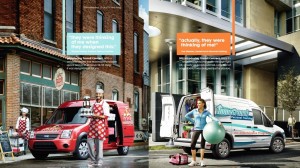
Fleet buyers, rather than retail customers, could provide the initial nudge needed to build demand for battery vehicles like the Ford Transit Connect EV.
When General Motors began testing the market to see who might be interested in buying a plug-in hybrid-electric vehicle, several years ago, “I stood up,” recalls Kris Trexler, a film editor from Los Angeles.
Having previously leased GM’s short-lived EV1 electric vehicle, a decade earlier, Trexler liked the fact that battery power could be both environmentally friendly and fun to drive. So he was one of the first “hand-raisers” for the Chevrolet Volt, which he recently learned will earn him the right to take delivery of the seventh car to roll off the assembly line once retail production begins.
GM is hoping to find thousands of battery car advocates in the months ahead as it ramps up production of the 2011 Volt. Meanwhile, Nissan says it has received so much interest in its new Leaf battery-electric vehicle, or BEV, that it had to cut preliminary orders off several months earlier than expected.
Nonetheless, many industry observers believe such early indicators could be misleading, and that once so-called “early adopters,” like Trexler, get their fill, demand for the new technology could plunge. At least on the retail side.
“The cost is still too expensive for consumers,” contends Stefan Jacoby, CEO of Volvo Cars. Instead, he believes, the real boom market “will be primarily among fleets for a considerable time.”
Fleet buyers, whether corporate or government could be the driving force that not only supports the nascent battery car market but which ultimately helps build up the economies of scale that will yield the better, cheaper battery cars needed to ultimately win over skeptical consumers.
That argument certainly gained credibility, earlier this month, when the industrial giant General Electric announced that it will switch to battery power for as much as half of its vast fleet of vehicles – perhaps 30,000 or more over the next several years. GE initially plans to purchase about 15,000 Chevy Volts and will turn to other makers, as well, as they bring their own offerings to market.
GE’s move is anything but altruistic. Sure, it will get bragging rights for operating the world’s largest battery-electric fleet. But General Electric, already one of the largest suppliers of electric grid technology is rapidly expanding into green power sources – and is the largest shareholder of A123, a producer of lithium-ion batteries. GE CEO Jeff Immelt noted, during a speech in London, that his company could eventually capture as much as 10% of the money spent on electric propulsion.
Building up a market for the new technology is also driving a number of utilities, including Michigan’s DTE Energy, to set up battery car fleets. But even those who don’t directly stand to gain from the technology’s success see advantages to electric propulsion.
While it’s easy to think of consumers as rational shoppers, that’s seldom the case, contends George Peterson, chief analyst with AutoPacific, Inc. If that were true, battery cars would likely be appropriate for many Americans, data showing that the average U.S. motorist rarely, if ever, drives more than 100 miles at a time, the typical range limit of a vehicle like Leaf. But retailer buyers are more likely to suffer range anxiety, fretting about the rare time they will take a longer trip.
Not so the typical fleet, Peterson contends, whose manager typically knows precisely how much any vehicle will be driven – and how much it will cost to operate. With energy for a battery car like Leaf costing about 2 cents a mile, less than a fifth what gasoline for a comparable model costs, there’s a potentially significant price advantage.
“Fleets have lots of cars, lots of people running around on prescribed routes, and central depots where it’s easy to set up charging stations that a company can get tax credits for.”
Without fleets helping move the needle, Peterson believes sales of battery-electric vehicles will be modest, at best, over the coming decade. Research by J.D. Power and Associates echoes that assumption. The California consultancy’s new Drive Green study forecasts battery cars – including everything from basic hybrids to plug-ins to pure electric models – will account for just 7.3% of the total global vehicle market by 2020.
Not everyone agrees, however. Joe Ewanick, GM’s North American marketing czar, believes battery car demand will outstrip the skeptics expectations as consumers get more familiar with the technology. In fact, he adds, “We want to see retail customers own our cars first,” to the point GM is stretching out the planned GE order so there will be enough Volts “to put in consumer hands during the first year.”
Toyota, meanwhile, wants to carefully balance fleet and retail demand when its RAV4 EV, a battery-powered crossover developed with the help of start-up Tesla Motors, comes to market in 2003.
“We want to see a mix of fleet and retail,” says Toyota’s top U.S. executive, Jim Lentz.
Ford is another maker testing both sides of the sales ledger. By the end of the year, the maker plans to launch a test fleet of battery-powered Transit Connect vans. Ford’s first consumer-oriented battery car, the Focus EV, won’t hit the road until 2012.
A different type of fleet may also play a role in helping build demand for battery cars. Another EV start-up, Coda, has just announced plans to partner with Hertz, which will make Coda sedans available at some of its Southern California rental offices. Nissan plans to put a small number of Leafs into rental operation, as will Chevy with the Volt.
While rental fleets are generally a low-profit line of business they do have the advantage of making it easy for interested – if skeptical – motorists to check out the technology without having to actually buy a battery car. But if they like what they experience, those motorists could head for the nearest showroom.
